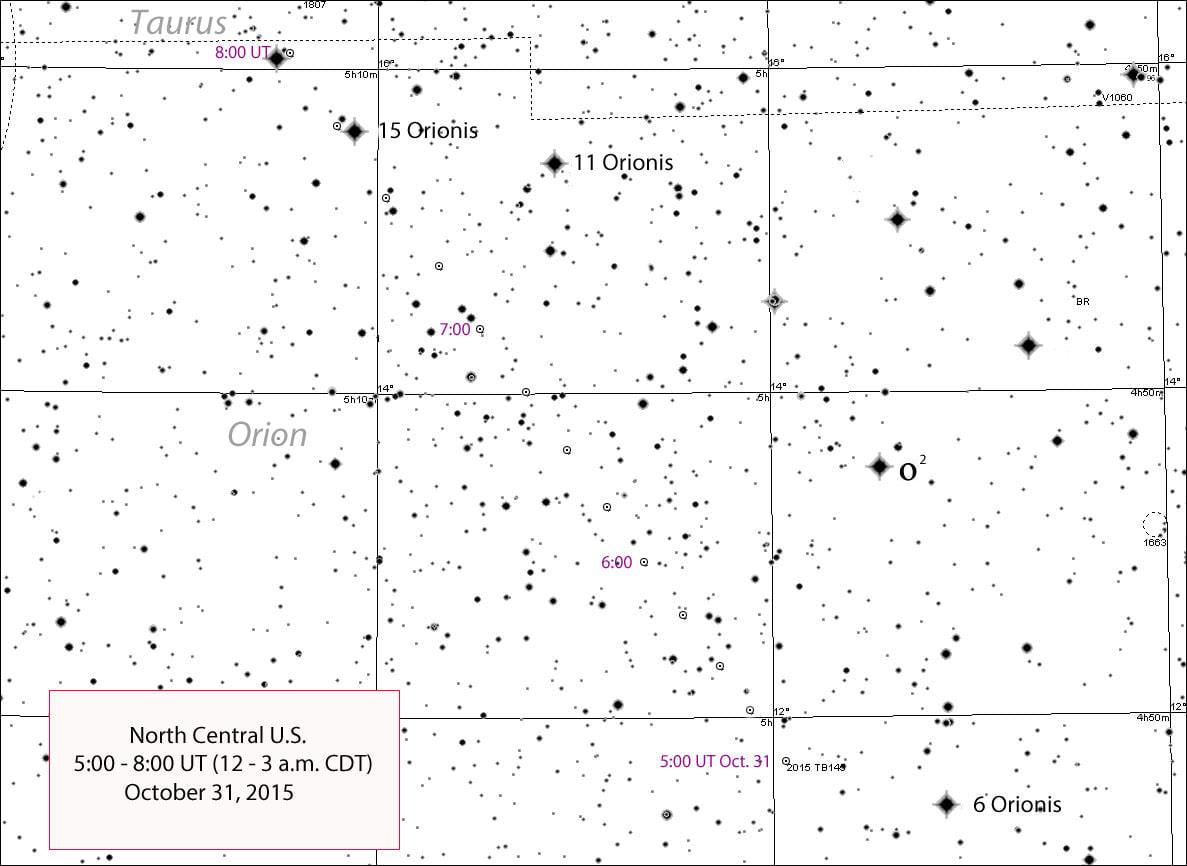This simulation by Tom Ruen shows the trajectory of 2015 TB145 across the sky, showing tracer spheres spaced at one hour intervals along its path.
Halloween fireballs, a Supermoon and now a
. What a week! While 2015 TB145 won't be visible in binoculars because of its relative faintness and glare from a nearby waning gibbous Moon, you should be able to see it in an 8-inch telescope or larger telescope without too much difficulty.
Determined amateurs might even catch it in instruments as small as 4.5 inches especially tomorrow morning when the fleeing space mountain will brighten to around magnitude +10.
For western hemisphere observers, TB145 begins the evening in Orion's Shield not far below the Hyades Cluster looking like a magnitude +11.5 star crawling northeast through the star field. By dawn on Halloween, it will top out around magnitude +10.2 as it zips through Taurus and Auriga traveling around 3-5° per hour depending on the time you look. For most of the night, TB145 will move swiftly enough to notice its motion in
real time
, resembling an Earth-orbiting satellite. Closest approach occurs around 17:00 UT (noon CDT) when it pass along bottom of the Big Dipper Bowl at around 10° hour. Amazing!
[caption id="attachment_123184" align="aligncenter" width="580"]
Map showing the asteroid's progress across the horns of Taurus from 9-10:45 UT (4 - 5:45 a.m.) October 31st. It passes about 1° northwest of the Crab Nebula around 10:30 UT. Credit: Chris Marriott's SkyMap[/caption]
My hope is that these maps will help you spot and follow this zippy, aircraft carrier-sized boulder. Three of the four maps cover
most
of the time between 5:00 and 11:45 UT, equivalent to midnight CDT tonight to 6:45 a.m. tomorrow morning. I used the very latest orbital elements and hand plotted the positions (a tedious exercise but worth it!) at 15-minute intervals. For convenience, when you print them out, I'd suggest using a straight edge to draw a line connecting the position dots.
As we discussed in the
previous Universe Today story,
parallax comes into play when viewing any nearby Solar System object. Three of the maps show the asteroid's position from the North Central U.S. One depicts the view from the South Central U.S. from 11-11:45 UT. Parallax is minor early on from midnight to 2 or 3 a.m. but becomes more significant near closest approach. This is based on comparisons I made between latitudes 47°-32° North.
[caption id="attachment_123186" align="aligncenter" width="580"]
By this time, TB145 will be around magnitude +10.4 and easier to see than at the start our run. The map covers the time from 11-11:45 UT (6 - 6:45 a.m. CDT). Credit: Chris Marriott's SkyMap[/caption]
I apologize for the limited number of maps in this article but hope these and the do-it-yourself approach described in the earlier article will be enough to set you on TB145's trail.
[caption id="attachment_123188" align="aligncenter" width="580"]
The view from the southern U.S. (about 32° latitude) from 11-11:45 UT. Compared to the northern U.S., the asteroid's path lies about 5 arc minutes further to the north. Credit: Chris Marriott's SkyMap[/caption]
As always when trying to spot asteroids on the move, pick a time and camp out at that spot with your telescope five minutes before the expected arrival time. Take the time to casually memorize the star patterns, so when the interloper arrives, you'll pick it out straightaway. Again, depending on your location both east-west and north-south of the paths charted, TB145 may arrive a couple minutes earlier or later, but once you spot it, hold on tight. You'll be going on a most exciting ride!
[caption id="attachment_123052" align="aligncenter" width="580"]
Map showing TB145's approximate path starting at 4 hours UT on Oct. 31 (11 p.m. CDT Oct. 30). This view faces east. Tick marks show its hourly position. This map provides context for the detailed maps above. Credit: Chris Marriott's SkyMap[/caption]
We'd love to hear from you whether or not you were successful seeing it. If the weather's uncooperative or you don't have a telescope, Gianluca Masi's got your back. He'll webcast the flyby live on his
starting at 7 p.m. CDT (0:00 UT) tonight Oct. 30-31.
Now let's see the flyby of Earth from the asteroid's point of view, also by Tom Ruen. Enjoy!
 Universe Today
Universe Today
